Cricetidae
15.2.3.14 Cricetulus sp. (Fig. 15. 18)
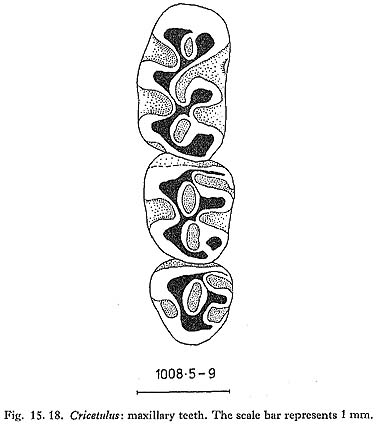
A single maxilla of Cricetulus (sensu lato) was found, with a complete tooth-row (Fig. 15. 18); measurements are as follows:

The antero-lingual cingulum of M2 is weakly developed, and the posterior part of M3 is relatively reduced.
Cricetulus is a genus of small hamsters; the only species that occurs today in the Near
East is C. migratorius, with which the Douara Cave specimen agrees closely in morphology and size. C, migratorius is widely adaptable, occurring in semi-desert and in forest conditions as well as commensally in houses and barns, but is most commonly found in dry steppic areas (Harrison, 1972).
Cricetulus has been widely reported from Pleistocene sites in the Near East, as also has the related genus Allocricetus (Bate, 1943; Tchernov, 1968). Tchernov recognizes two species of Allocricetus, A, jezreelicus and A. magnus, but the differences that he describes as separating Allocricetus from Cricetulus are not regarded as useful generic discriminants by Mayhew (1978), who calls for further study of the question. The development of the antero-lingual cingulum in M2 is used as a discriminant by Tchernov; Mayhew comments that it is variable in both genera, and that its development in Cricetulus increases disproportionately with size: the weak cingulum of the Douara Cave specimen would be consistent with its relatively small size. The posterior part of M3 is less reduced in the specimen of A. jesreelicus illustrated by Bate (1943: Fig. 6), but equally reduced in the specimen figured by Tchernov (1968: Fig. 58); again, as Mayhew (1978: Fig. 2) suggests, this may be related to the size of the animal.
15.2.3.15 GerUllus (Dipodillus) sp. (Figs. 15. 19 and 21)
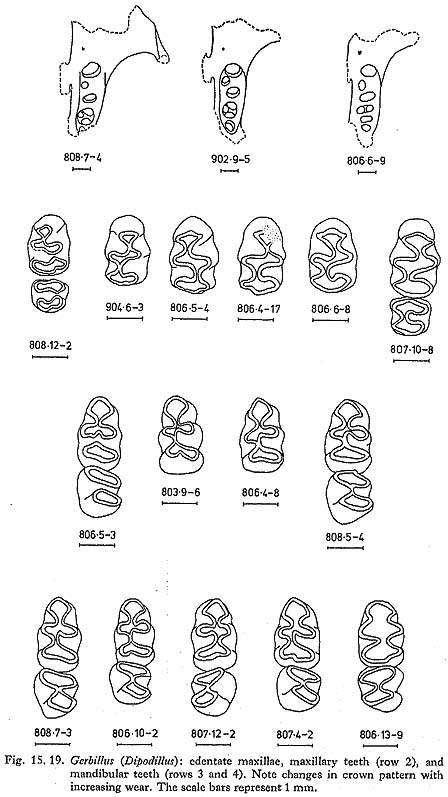
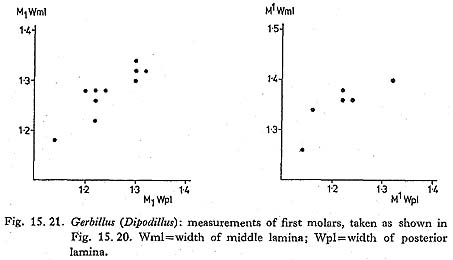
Gerbillus is fairly common. M1 (Fig. 15. 19) is typical of the Dipodillus group (treated as a separate genus by Osborn and Helmy, 1980) in having the lingual cusp of the middle lamina anterior to the labial cusp ("alternate") at least in immature individuals; in the GerUllus group these two cusps are level with each other ("opposite") at all ages. Measurements are as follows (see also Fig. 15. 21 and Table 15. 1):

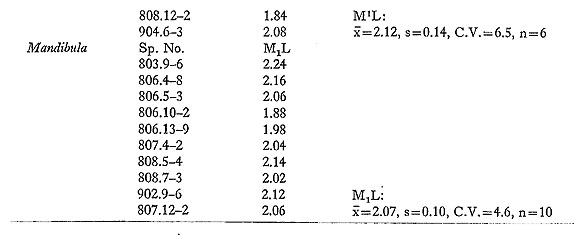
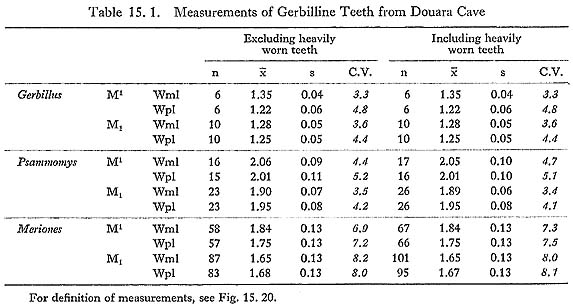
A number of Gerbillus species occur in the Near East today. All are typically desert or semi-desert animals. They are apparently scarce as fossils, but this may be a consequence of their small size, which means that they are easily missed without careful sieving. Gerbillus from the Acheulian levels at Oumm Qatafa has been identified as G. dasyurus (Tchernov, 1968: Fig. 64); they appear to resemble the Douara Cave material closely. It is tempting to identify the Douara Cave specimens as G. dasyurus, which is the only Gerbillus found today in the Palmyra area; but other species, such as G. nanus, are very similar.
15.2.3.16 Psammomys sp. (Figs. 15. 22, 23 and 24)
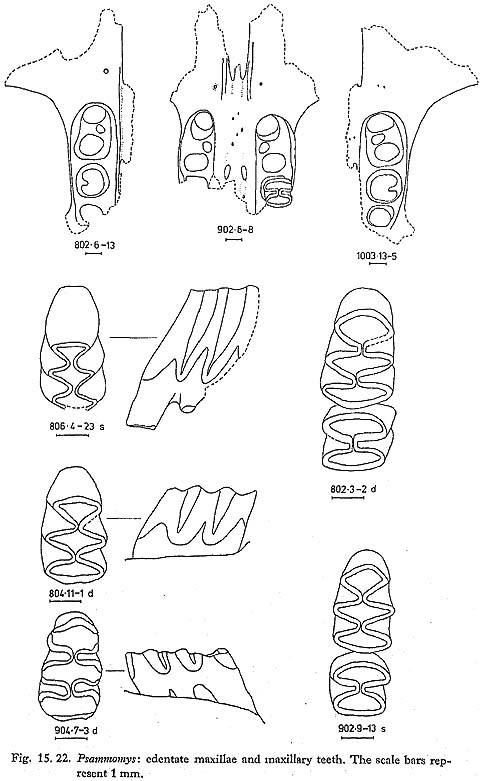
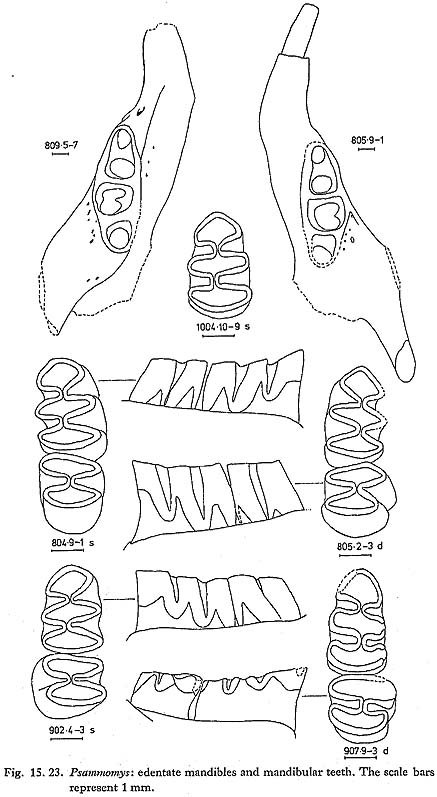
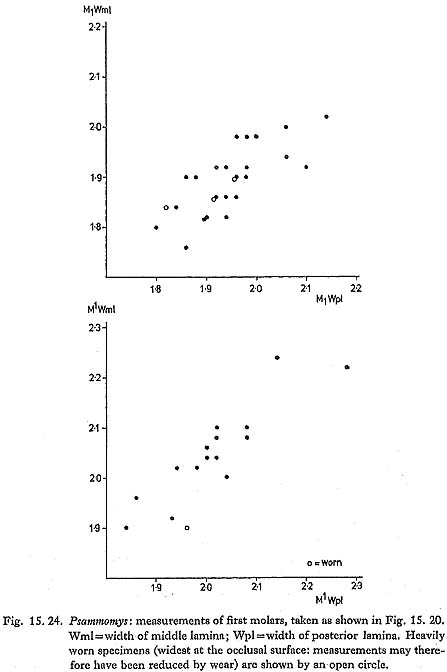
Teeth and jaws of Psammomys are fairly common at Douara Cave; some of these are illustrated in Figs. 15. 22 and 23. Differences in crown pattern between the cheek teeth of Meriones and Psammomys are by no means as clear as Haas (1966: 40-41) suggests, since the crown pattern changes considerably according to the amount of tooth wear. A clearer and more consistent difference is seen when the teeth are viewed from the side (either labially or lingually); in Meriones (Fig. 15. 28), the base of the enamel is fairly flat, with low, rounded embayments up each lamina; while in Psammomys (Figs. 15. 22 and 23), the embayments run much higher up each lamina and have more pointed ends. Identification of the Psammomys specimens is confirmed by the typical forward position of the posterior end of the incisive foramina, and by the reduced posterior palatine foramina (Fig. 15.22), as well as by the presence in the sample of ungrooved upper incisors. Edentate jaws can usually be distinguished by the alveolar pattern: in Douara Cave Psammomys, M2 has two confluent alveoli (Fig. 15. 22), M1 has two alveoli, and M2 has two confluent alveoli (Fig. 15. 23); while in Douara Cave Meriones, M2 usually has two separate alveoli, M1 has three alveoli, and M2 has two separate alveoli (Fig. 15. 29). Occasional variants were found and are illustrated; thei ridentification is usually clear from the other alveoli, from the positions and sizes of the foramina in maxillae, and from the smaller size of most of the Meriones specimens.
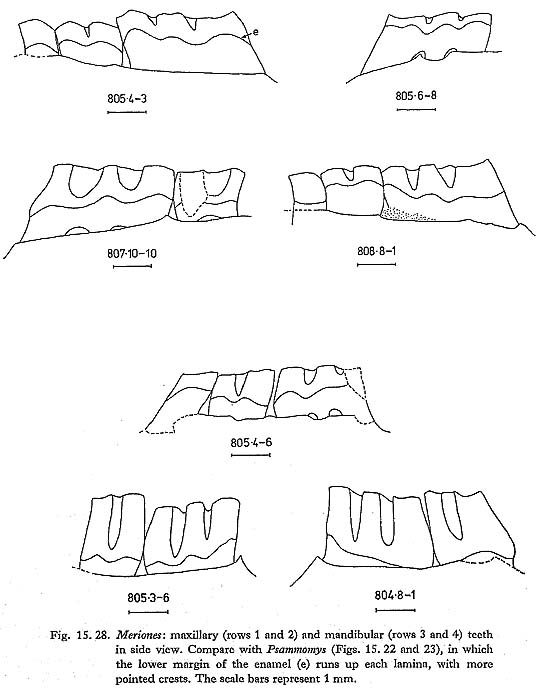
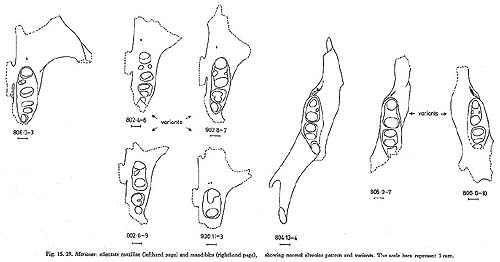
Fig.15.29 |
Measurements of Meriones and Psammomys cheek-teeth present considerabr laminae of the first molars, defined as shown in Fig. 15. 20, which remain reasonably constant until wear is far advanced. Measurements for Douara Cave Psammomys are given in Table 15. 1 and in Fig. 15. 24.
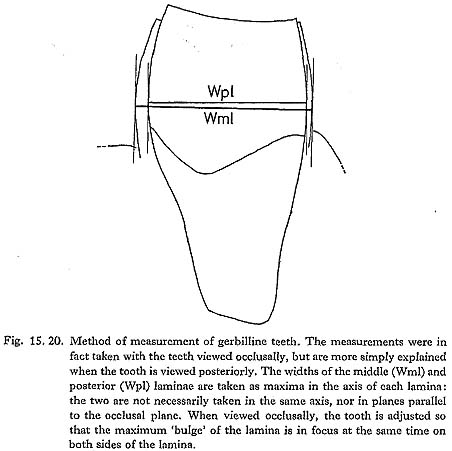
P. obesus is the only species, and is found in North Africa and in the Arabian peninsula; it is relatively specialized, living mainly on succulent desert plants such as Anabasis and Hammada (Osborn and Helmy, 1980). The Douara Cave specimens are of similar size to
P. obesus. Fossil records are scarce; a few specimens have been reported from Oumm Qatafa (Haas, 1951; Tchernov, 1968).
15.2.3.17 Meriones spp. (Figs.15.25-32)
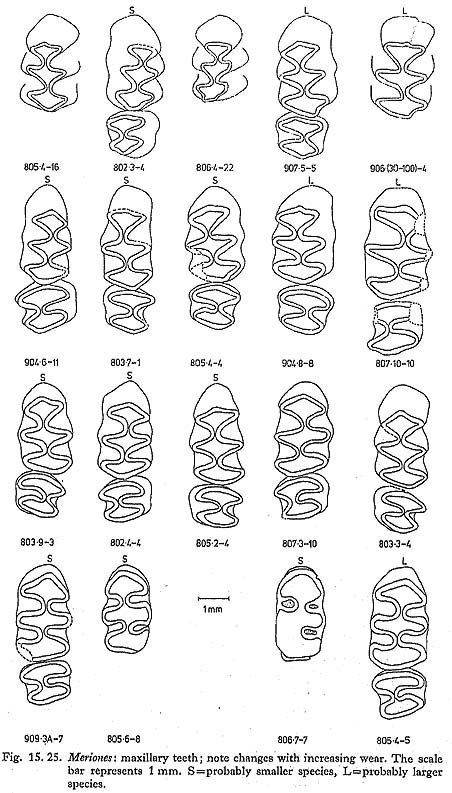
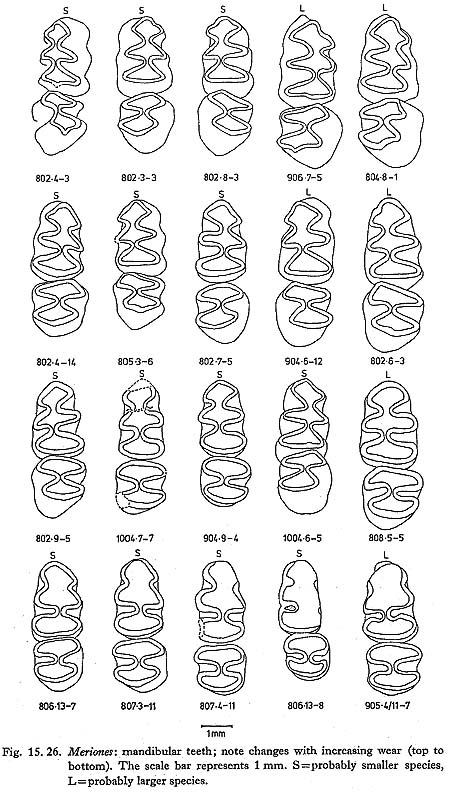
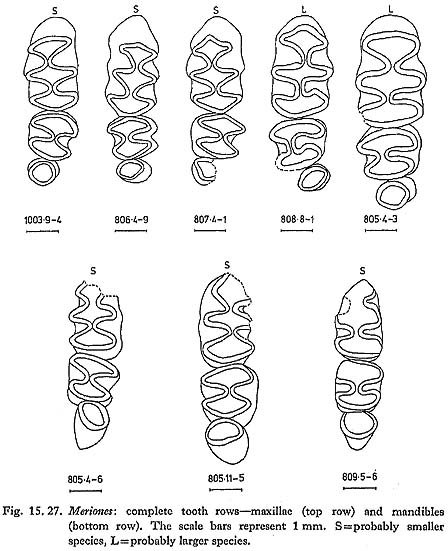
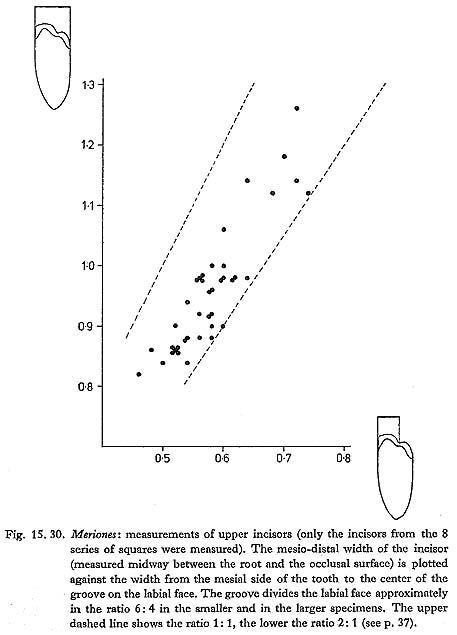
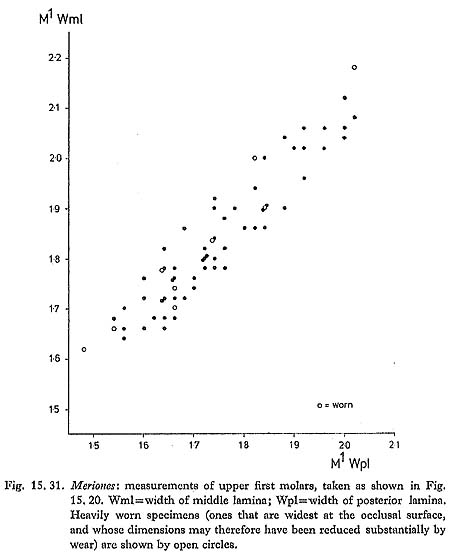
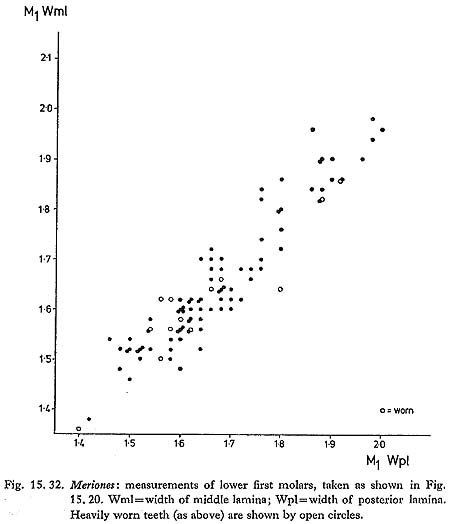
Meriones is the commonest rodent genus in the Douara Cave fauna (Table 15.9); selected specimens are illustrated in Figs. 15. 25-29. Distinctions between Meriones and Psammomys are discussed above (p. 30). Measurements are given in Table 15. 1, and are shown in Figs. 15. 30-32. These measurements suggest that more than one species is present: coefficients of variation, are higher than are expected for a single species (Table 15.1: values for Meriones range from 6.9 to 8.2, as compared with 3.4 to 5.2 for Psammomys and 3.3 to 4.8 for Gerbillus), and Figs. 15. 30-32 show some indication of the presence of two overlapping clusters, a smaller form being considerably commoner than a larger form. That the two forms are males and females can reasonably be excluded, since sexual dimorphism in modern Meriones is nowhere near as large as the 15 to 20% size difference between the clusters indicated by Figs. 15. 30 and 15. 32 (compare data given by Harrison, 1972, and by Osborn and Helmy, 1980). Two lower first molars (Fig. 15. 32) stand out as unusually small; one is heavily worn and probably belongs with the smaller cluster, while the other looks rather fresh and may be intrusive: it is from unit 8-05.3, which is fairly close to the surface.
A tentative separation between the smaller (8) and the larger (L) forms is indicated in Figs. 15.25-27. Morphologically, no consistent differences were found: there is considerable variation in crown pattern, but this seems to be related to wear: as Figs. 15. 25 and 26 show, with increasing wear the crown pattern becomes less angular, connections between the laminae widen, and minor folds, such as on the antero-labial wall of the anterior lamina in M1, disappear. In both forms, the groove in the upper incisor divides the labial face roughly in the ratio 6 (mesially) to 4 (distally) (Fig. 15. 30).
A large number of Meriones species have been described, and Harrison (1972) recognizes seven species in the Near East. Distinctions are based on pelage characters and on the
structure and size of the auditory bulla, neither of which is available for the Douara Cave sample. The structure of Meriones teeth is simple, and appears to vary little within the genus. Haas (1966) gives some differences between species in describing M. obeidiensis, from the early site of 'Ubeidiya, but none of these are constant in large samples with a wide range of wear stages. Haas also says that the position of the groove in the labial face of the upper incisor can be used as a diagnostic character, and that in M. obeidiensis it lies in the center of the labial face, while in M. crassns and in M. sacramenti it divides the labial face in the ratio 2 (mesially) to 1 (distally). This was not confirmed however, in examining a large series (including all seven Near Eastern species) of Meriones in the collection of the British Museum (Natural History); in all these species, as also in the two Douara Cave forms, the ratio is around 6 (mesially) to 4 (distally), which lies between the figures given by Haas for M. obeidiensis and for the modern species (Fig. 15. 30).
No specific identification is therefore suggested for the Douara Cave Meriones; the larger-sized group is of animals only a little smaller than Psammomys, and about the size of modern M. sacramenti, M. libycus and M. rex; while the smaller-sized cluster is of animals about the size of modern M. crassus and M. tristrami.
Meriones are steppe and desert rodents. Some species penetrate north into Turkey (M. tristrami) and Iran (M. persicus, M. vinogradovi), where they are confined to open dry habitats; others, such as M. libyciis and M. crassus, are semi-desert and desert species.